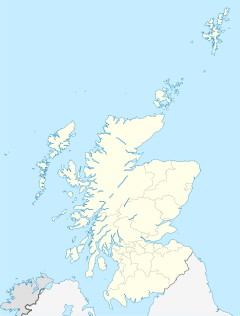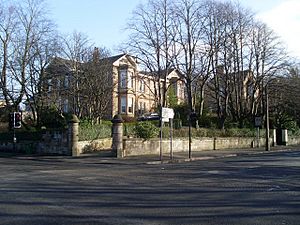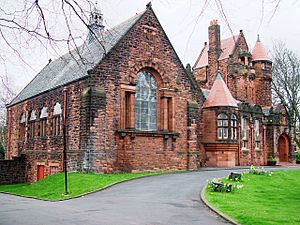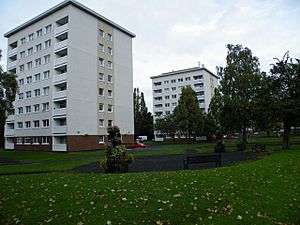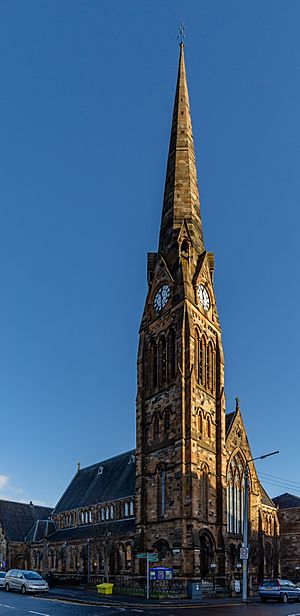Pollokshields facts for kids
Quick facts for kids Pollokshields |
|
|---|---|
 Albert Drive, East Pollokshields |
|
| Area | 1.59 km2 (0.61 sq mi) |
| Population | 9,738 (2015) |
| • Density | 6,125/km2 (15,860/sq mi) |
| Language | English, Scots |
| Council area | |
| Lieutenancy area |
|
| Country | Scotland |
| Sovereign state | United Kingdom |
| Post town | GLASGOW |
| Postcode district | G41 |
| Dialling code | 0141 |
| Ambulance | Scottish |
| EU Parliament | Scotland |
| UK Parliament |
|
| Scottish Parliament | |
Pollokshields (Scottish Gaelic: Buthan Phollaig, Scots: Powkshiels) is a cool area in the Southside of Glasgow, Scotland. It's surrounded by some clear boundaries. To the west, there's the M77 motorway and the big, open Pollok Country Park. Railways form other borders, separating it from industrial areas like Kinning Park. Another railway line runs along its southern edge, next to neighborhoods like Govanhill and Shawlands. There's also a local train line that goes right through Pollokshields.
Pollokshields is a special "conservation area." This means its old buildings and unique style are protected. It was planned and built during the Victorian era (a long time ago, when Queen Victoria was in charge). The land belonged to the Stirling-Maxwell Baronets family, who had owned it since 1270! The area has two main looks: the western part has large houses with gardens on curvy, tree-lined streets. The eastern part, which used to be a separate town, has three-story sandstone tenements (apartment buildings) arranged in neat blocks, just like many other parts of Glasgow from that time.
Contents
Discovering Pollokshields' History
Pollokshields was officially started by the Stirling-Maxwell family in 1849. An architect from Edinburgh, David Rhind, helped design how the area would be laid out. Many famous Glasgow architects helped build Pollokshields, including Alexander 'Greek' Thomson, who designed some of the villas (large houses).
Other architects, who worked around the same time as Charles Rennie Mackintosh, also added their touch. For example, Harry Clifford designed some beautiful "Glasgow style" tenements. He also created the amazing Pollokshields Burgh Hall, which opened in 1890. The land for Maxwell Park was given by Sir John Stirling-Maxwell in 1888, and the park opened at the same time as the Hall.
Pollokshields grew so fast that it became its own small town, called a 'burgh', in 1876. But this didn't last long! In 1891, the people living there agreed to become part of the bigger city of Glasgow, especially because they were offered better tax deals. Even today, the old Victorian and Edwardian buildings and parks are still there, making Pollokshields feel like a green, old-fashioned suburb, even though it's right inside the city.
In May 2021, something amazing happened on Kenmure Street. People in the community came together to protest when officials tried to take two men from their homes. Hundreds of people surrounded the van, and one person even lay under it for nine hours! They didn't move until the men were released. With help from lawyers and politicians, the men were allowed to go back home. This protest showed how strong and supportive the Pollokshields community is.
The Historic Burgh Hall
The Pollokshields Burgh Hall was designed by Harry Clifford in the late 1800s, during a time called the Scottish Renaissance. It's a very important building in Pollokshields today. It was built using a special red stone called Ballochmyle Red Freestone and opened in 1890. Sir John Stirling Maxwell, whose family started Pollokshields, opened the Hall. You can even see his family's coat of arms carved in stone at the entrance!
The Hall has a tall tower with a balcony at one end. Inside, there are detailed stained-glass windows that show scenes from Pollokshields. Next to the Hall is a small house called the lodge house, which used to be where the building's caretaker and park gardener lived. Now, these are rented out. In 1891, the Burgh Hall became part of Glasgow Council when the city grew bigger. Later, in 1938, the back of the building was made larger.
By 1975, the Hall was being used as a community center. But in 1982, there was a plan to sell it. The people of Pollokshields were very upset because the Hall was important to their history. They protested, and because of their efforts, a special charity group was formed. This group bought the building for just £1 in 1986, making sure it would stay owned by the public. The lodge house and the main floor of the Hall were completely fixed up and reopened around 1997. Later, the lower ground floor, which used to be just a cellar, was turned into a modern meeting room.
Learning in Pollokshields
Pollokshields has many great schools for kids of all ages. There are five primary schools: Pollokshields Primary, Glendale Primary (which shares a campus with Glendale Gaelic School), St. Albert's Primary, and the private Craigholme School for Girls.
For older students, there are four secondary schools: Bellahouston Academy, Shawlands Academy, Craigholme School Secondary (an extension of the primary school), and Hutchesons Grammar School, which is a private school with its main campus in Pollokshields.
People of Pollokshields
In 2015, the wider area of Pollokshields had about 27,983 people living there. This number includes other nearby neighborhoods too.
Pollokshields is known for being a very diverse place, with people from many different cultures and backgrounds living together. There's a large Pakistani community, which adds to the rich mix of cultures in the area.
Pollokshields' Buildings
The buildings in Pollokshields are mostly a mix of Victorian tenements (apartment buildings) and large houses, both detached (standing alone) and semi-detached (joined to one other house). These buildings were mostly built in the late 1800s and early 1900s.
There are also some more modern buildings. For example, on St Andrew's Drive, there are seven cube-shaped apartment blocks from the 1960s. These have been updated in recent years.
Pollokshields has several interesting churches. The Church of St Albert the Great was originally built for a different church group. It has an Italian Renaissance design with a cool octagonal entrance and a tall bell tower. The Archdiocese of Glasgow bought it in 1965 and turned it into a Catholic church.
Pollokshields Parish Church was built in 1877-1878. It has a mixed Gothic style with a tall tower and a clock on each side. Inside, it has beautiful polished granite columns and a high, detailed wooden roof.
Sherbrooke St. Gilbert's Church is another Church of Scotland church. It was built in 1894 and had to be rebuilt after a big fire in 1994. You can find it on Nithsdale Road, near Dumbreck railway station.
Sports and Recreation
Clydesdale Cricket Club is located in Pollokshields. It's a very old sports club, started in 1848! It's the oldest surviving team sports club in Glasgow. When the club moved to Pollokshields in 1873, it sold its old grounds to a new football club that later became the famous Rangers. The club also had a football team called Clydesdale, which played in the very first Scottish Cup final in 1874.
Getting Around Pollokshields
Pollokshields has great public transport links. There are three train stations within the area: Maxwell Park, Pollokshields East, and Pollokshields West. All of these are on the Cathcart Circle Line. Other nearby stations include Crossmyloof and Dumbreck.
The area is also served by Shields Road subway station on the Glasgow Subway, which is a great way to get around the city. Plus, many bus routes run through Pollokshields. For cars, major motorways like the M8, M74, and M77 are all close by, and the A77 road runs along the eastern side of the area.
Famous Faces from Pollokshields
Many interesting people have lived in Pollokshields, including:
- Dougie Donnelly – a Scottish TV and radio personality.
- Jane Haining – a brave Church of Scotland missionary who helped protect Jewish children during World War II.
- Frankie Boyle – a well-known comedian.
- Rustie – a talented musician.
- Eric Woolfson – a songwriter and musician, who helped create the Alan Parsons Project.
- Tom Urie – an actor.
- Raymond McGinley – a musician.
See also
- Pollokshields Library
- Shieling


